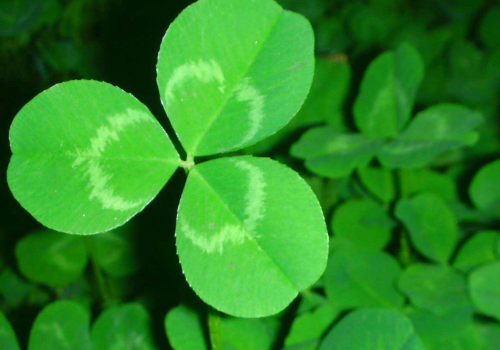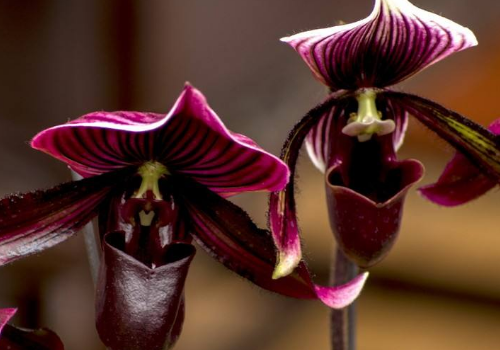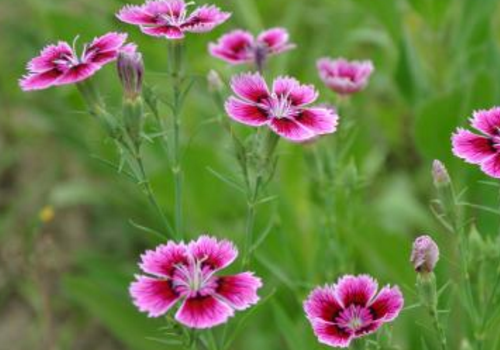What is the difference between clover seeds and four-leaf clovers?
Clover, this is also a kind of plant, is a kind of plant that many people know, can be good-looking, can raise a large area, then how to grow this clover seed? What's the difference between a clover and a four-leaf clover:
How to plant clover seeds:
1. Sowing and seed treatment. The best time for white clover sowing is in spring and autumn, and the optimum growth temperature is 19-240C. Spring sowing can be from the end of March to the end of April, and the temperature is above 150C. Autumn sowing is usually from mid-September to late September. The seeds should be soaked before sowing, adding 1.5 jin of water per jin of seeds, adding 1 gram of ammonium molybdate for 12 hours, adding 5-10 kg of calcium magnesium phosphate fertilizer and 5-10 kg of fine soil or 5-10 kg of yellow sand.
2. Land preparation. The seeds of white clover are small, and the soil force at the top of the seedlings is poor, so the ground must be leveled and raked fine before sowing to facilitate seedling emergence. When planting in areas with heavy soil and heavy precipitation, ditches should be made to facilitate drainage. For planting and using fresh grass in mountainous areas, it is appropriate to choose areas with more shade or moist soil. Interplanting in the orchard should remove weeds and loosen the soil between the rows of fruit trees before sowing, level the ground, and sow 1-2 days before rain.
3. Planting mode. Fruit trees can be planted between rows, can be sowed or sowed, and the row spacing is 15 cm. Sowing should be shallow rather than deep, generally 0.5-1.5 cm. Single sowing, 0.5-0.75 kg per mu, sowing or strip sowing, strip sowing row spacing 30 cm. It is better to sow seeds after dressing with the same amount of fertile soil. When mixed with oxtail grass and ryegrass, the sowing amount was reduced appropriately. Weeds should be removed at the seedling stage to facilitate the formation of white clover.
4. Fertilization. White clover belongs to legume, which has the ability of nitrogen fixation, but the rhizobium has not been formed at seedling stage, so it is necessary to supplement a small amount of nitrogen fertilizer, a small amount of nitrogen fertilizer is beneficial to strong seedlings, and the application of phosphorus and potassium fertilizer has a good effect on increasing yield. After the formation of the flat, only phosphorus and potash fertilizer is needed. Before sowing, apply 20-25 kg of calcium superphosphate per mu and a certain amount of barnyard manure as base manure. When the plants are short and the leaves are yellow, a small amount of nitrogen fertilizer should be applied. Generally, 2.5 kg of urea, 5 kg of potassium fertilizer and 5 kg of calcium magnesium phosphate fertilizer should be applied 15 days after emergence to promote strong seedlings and increase grass yield.
5. Field management. White clover grows slowly in seedling stage and is vulnerable to weeds, so weeds should be removed frequently in seedling stage, especially in spring sowing. Sowing in September, blooming in April and blooming in mid-May, the grass layer is 15-20 cm high during flowering, which is the suitable time for cutting and utilization. After cutting, the regeneration ability is strong, and the second stubble grass layer is quickly formed to cover the grassland. In the hot season, white clover stops growing. Large weeds should be removed in time in 2-3 years after the formation of grass cover. If the lack of seedlings is caused by high temperature and drought in summer, it can be reseeded in autumn to restore grassland productivity. If a large area is planted as grazing land, light grazing can be carried out 1-2 months after sowing and when the weeds are 20-25 cm high to inhibit the growth of weeds. The disease of white clover is less, but the harvest is not timely, and sometimes brown spot and powdery mildew occur, which can be cut and used first, and then controlled by Bordeaux solution, stone-sulfur mixture or carbendazim.

What's the difference between clover and four-leaf clover:
Clover, a perennial herb, usually has only three small leaves, which are heart-shaped in shape, and the darker part of the leaf center is also heart-shaped.
Four-leaf clover is a variation of clover.
In one hundred thousand clover plants, you may find that only one is a four-leaf clover, with a chance of about one in a hundred thousand. The edge of the four-leaf clover should be serrated and the leaves near the center should be dark black. The saying of four-leaf clover and lucky clover is precious because it is rare.
This is the end of the introduction to the planting method of clover seeds, so let's figure out the difference between clover and four-leaf clover. It's just an extra leaf.
Seed sowing method of clover
Clover (clover is a rare variety of clover) is a general term for many herbs with three finger-shaped compound leaves. It mainly includes some species of Trifolium, Medicago sativa and Oxalis in Leguminosae (Leguminosae). The method of reproduction is mainly sown and propagated. Let's take a look at the seed sowing method of clover.
Clover sowing time
Clover can be sowed in spring or autumn, spring in late March, autumn in mid-September, autumn sowing in the south, spring sowing in the north, and sowing in summer, but the topsoil must be moist or shaded with mulch after sowing. The suitable sowing rate of clover is 8 grams per square meter, and there are 1400 and 2000 seeds per gram of clover. Theoretically, one seed per square centimeter of soil can meet the needs of forming a flat, and the actual sowing rate is larger than the theoretical sowing amount.
Sowing method of clover
When sowing clover, divide the seeds equally according to the area of the land and the determined sowing amount, mix the seeds with dry soil or fine river sand, and sow them manually. If the lawn is planted in a large area, it can be sown with a whirlwind seeder with a depth of 1 cm. After the seeds are sowed into the turf bed, the seeds can be raked into the soil with lawn rakes, or covered with fertile soil or matrix.
Management of clover after sowing
The main results are as follows: 1. The management before the formation of the flat: the clover grows slowly at the seedling stage. After the seeds are sown in the turf bed, sprinkler irrigation can be carried out if the sprinkler irrigation system is installed in advance, and the self-made sprinkler can be used for artificial irrigation if there is no sprinkler irrigation system. Spray every morning or evening, always keep the surface of the turf bed moist until emergence, after emergence can reduce the number of spraying, but still need careful management, seedling management of about 30 to 50 days, in addition to pay attention to watering to keep the turf bed moist, but also to remove weeds at any time, mainly manual pulling, to prevent weed harm.
2. Management after the formation of the flat: because of its strong invasiveness, clover does not need to carry out intermediate ploughing and weeding, because nitrogen-fixing rhizobium can absorb nitrogen in the air and transform into a form that can be used by plants. Therefore, fertilization is mainly phosphorus and potassium fertilizer, no or less nitrogen fertilizer. In the growing season and overwintering, it is necessary to provide sufficient water to ensure exuberant growth and safe overwintering. Before the height of summer, it can be cut once and watered enough to keep the plant green. Cut it again before overwintering and pour enough winter water. In this way, when it turns green in the coming year, there will be no withered and yellow branches and leaves on the flat surface. Anti-pollution, anti-disease and insect pests are strong, diseases and insect pests are less, when found leafhoppers, weevil, ground tiger and other pests, you can use dimethoate, dichlorvos and other spray.
What's the use of how to grow clover?
Clover is a very common plant, which is very similar to alfalfa in morphology. Clover is a symbol of happiness, so it is usually planted in the courtyard. At the same time, clover represents luck. Once you find a clover with four leaves, it means that something good is coming.
How to plant clover
1. Soil
The seeds of clover are small, the emergence ability of seedlings is weak, and the growth in seedling stage is extremely slow. Before planting, it is necessary to plough the ground deeply, level the ground, break the soil into pieces, and make the sowing layer soil loose and smooth.
2. Sowing seeds
The best sowing time of clover is in spring and autumn. Spring sowing can be from the end of March to the end of April, and the temperature is above 15 ℃. Autumn sowing usually starts from the middle to late September. The seeds of clover need to be soaked before sowing, add water 1.5kg per 1kg seed, add 1g ammonium molybdate to soak seeds for 12 hours, mix fine soil with calcium magnesium phosphate fertilizer 5-10kg or yellow sand 5-10kg, and sow seeds.
3. Fertilization
Clover belongs to legume, which has the ability of nitrogen fixation, but the rhizobium has not been formed at seedling stage, so a small amount of nitrogen fertilizer should be added to strengthen seedlings, and the application of phosphorus and potassium fertilizer can increase yield. When the clover grows up, it only needs to supplement phosphorus and potash fertilizer.
4. Maintenance
The clover lawn which has been growing for more than 2 years has compact soil layer and poor air permeability. before turning green in spring and autumn and before regeneration after grazing and cutting, it is necessary to rake and loosen the soil, combined with soil topdressing to facilitate the growth and development of new buds and roots. Clover has higher requirements for soil moisture, irrigation conditions, when the soil is dry, or combined with topdressing irrigation.
5. Diseases and insect pests
There are few diseases of clover, but the harvest is not timely, and sometimes brown spot and powdery mildew occur, which can be cut and used first, and then controlled by Bordeaux solution, stone-sulfur mixture or carbendazim.
What's the use of clover?
1. The medicinal value of clover.
There are mainly two kinds of clover, one is clover, in which the medicine is called "Sanxiao clover", and its flower color is white and red, which has the effect of clearing heat and cooling blood; second, sorrel, some wild flowers are yellow, and some are purple leaves or red flowers; it also has the effect of clearing heat and cooling blood and calming the nerves. Clover has a certain therapeutic effect on jaundice, gastric ulcer bleeding and other diseases, as well as relieving symptoms such as stomach heat pain and weakness of spleen and stomach. So the value of clover can not be underestimated, the small body is of great value.
2. The decorative function of clover.
As a fresh plant, potted clover can be used as a green plant for family decoration, which can not only comfort the family environment, but also beautify the family atmosphere. You can also co-plant with other plants as a foil to appreciate the beauty from another point of view.
3. The greening and planting value of clover.
Clover is widely distributed and adaptable, among which Trifolium repens is a kind of excellent forage grass rich in protein and minerals, which can be adapted in both acidic and alkaline soil, so it has a great prospect in China. At the same time, because it also plays a huge role in soil and water conservation, it can be used as a green plant, in addition to decoration, it can also be planted in a large area, which has good economic and ecological benefits.
The flower language of clover
The flower language of clover is happiness and luck.
The story of the clover
According to legend, whoever finds a clover with four leaves, that is, four-leaf clover (also known as lucky clover), will be happy. So in some European countries, people who see clover on the side of the road almost always put it away and flatten it so that they can give it to others in the future to express their best wishes to their friends.
In Ireland, everyone wears a clover bouquet on St. Patrick's Day on March 17 every year. St. Patrick is said to have explained the Trinity to the freedom-minded Irish with a clover. But now it is difficult to determine whether St. Patrick used the metaphor of clover or the azure grass with yellow flowers. However, the clover is a typical symbol inherited by Christianity. It has long been a symbol of the three priestly ranks of the Celts. And the vigorous growth of clover also makes it a symbol of vitality. Druitt has long given the four-leaf clover the same meaning as it is today, and that is happiness.
But in fact, the four-leaf clover is not difficult to find, but people still have a yearning for the four-leaf clover, because the four-leaf clover represents people's good wishes and hopes that good things will happen to them. Especially for young girls, the symbolic significance of the four-leaf clover is very great.
- Prev

Is Paphiopedilum suitable for indoor planting? is it harmful to the human body?
Aristolochia, which is also a kind of plant, is a kind of plant that many people like. It looks good, so is it suitable for indoor planting? Is it harmful to the human body: is Aristolochia suitable for indoor planting: Paphiopedilum is a terrestrial plant. Wild Aristolochia grows on rocky trees. The plant is small and suitable for potted plants.
- Next

What is the difference between how to plant colorful carnation seeds and how to grow carnation in summer?
Colorful carnation, this is also a kind of plant, is a lot of people know, super many people know, then how to plant this colorful carnation seed? What is the difference between carnation and carnation in summer: how to plant colorful carnation seeds: common sowing, cutting and ramet propagation
Related
- Fuxing push coffee new agricultural production and marketing class: lack of small-scale processing plants
- Jujube rice field leisure farm deep ploughing Yilan for five years to create a space for organic food and play
- Nongyu Farm-A trial of organic papaya for brave women with advanced technology
- Four points for attention in the prevention and control of diseases and insect pests of edible fungi
- How to add nutrient solution to Edible Fungi
- Is there any good way to control edible fungus mites?
- Open Inoculation Technology of Edible Fungi
- Is there any clever way to use fertilizer for edible fungus in winter?
- What agents are used to kill the pathogens of edible fungi in the mushroom shed?
- Rapid drying of Edible Fungi

